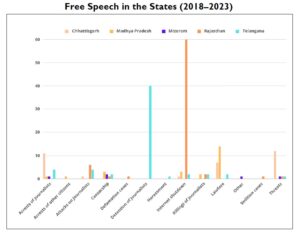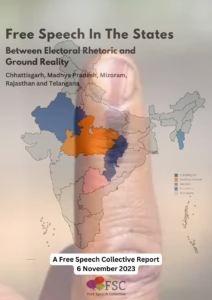Academic freedom is about the right to study, teach and research a diversity of viewpoints. Yet, this right that is so crucial for the pursuit of knowledge has seen widespread attacks in colleges and universities across India.

Excerpt from a status report by Nandini Sundar and Gowhar Fazili
(Download the full report from The India Forum here
Institutional harassment of faculty and
students who dissent
In the case of students who dissent, universities are routinely resorting to rustication, explusion, and withholding of scholarships. In an emblematic case from Hyderabad Central University, a Dalit student, Rohit Vemula, died by suicide , bringing to light the extent of caste discrimination and arbitrary decision-making within universities and sparking nationwide calls for legislation to address campus discrimination.
Following an altercation between the Ambedkar Studies Association (ASA) and the ABVP, the union education ministry intervened on behalf of the ABVP students, putting pressure on the university to take action against the ASA. The University took unprecedented and extreme action. The ASA students were not just rusticated from their hostels and their fellowships withheld, they were institutionally ostracised. The students responded by sleeping under a tent in the open, symbolically recreating a velivada, or dalit ghetto, on campus, highlighting
the aspect of caste discrimination.
Public universities have tried to impose service rules which would prohibit faculty from writing for the press, participating in demonstrations, and a variety of other activities. In the case of faculty, public universities have denied leave, stalled or refused promotions, withheld retirement benefits or tried to impose service rules which are applicable to central government employees on university faculty. This would prohibit faculty from writing for the press, participating in demonstrations, and a variety of other activities. In 2019, fortunately, the Delhi High Court stayed the JNU vice chancellor’s attempts to penalise faculty for not observing these rules.
The case of Manipur University is particularly egregious. As it is, there is a permanent army camp inside the campus, part of the overall militarisation of the state of Manipur which has long seen insurgency and counterinsurgency. The university was shut for several months in 2018, as students and teachers protested against the vice chancellor, A P Pandey for ‘administrative inpetitude’ and ‘saffronisation’ (carrying out the RSS agenda). The vice chancellor suspended both the faculty and the student unions, and police were brought in. Pandey was finally dismissed in February 2020.
In public universities, once you have ‘permanent employment’, service rules help in avoiding dismissal. However,increasingly, universities are run on the basis of ad hoc or contractual employees (up to 40% in the case of Delhi University). In private universities, there is even less security of tenure.
[In cases of wrongful termination] courts have enforced the right to academic freedom of the faculty member. However, going to court is time consuming, expensive and uncertain and hence cannot really be a guarantee of academic freedom. Termination, however, is rare – and in two cases which have come to light, the courts have enforced the right to academic freedom of the faculty member. However, going to court is time consuming, expensive and uncertain and hence cannot really be a guarantee of academic freedom.
The termination of Magsaysay awardee Sandeep Pandey from IIT BHU on grounds of being “anti-national” and showing banned films, which was subsequently quashed by the Allahabad High Court, was one instance where a contract was used to discipline dissent. In another case, Subroto Roy vs The Union of India and ors, which was decided by the Calcutta High Court on 9 January 2019, a professor in the management school of IIT Kharagpur whose contract had been terminated for whistleblowing on corruption, was compensated by the court. The court noted that there had been breach of
contract, but since the contract period had expired the remedy chosen was compensation. Among other issues, the petitioner had complained that his letter of appointment had assured him of IIT’s “strong tradition of academic freedom.”
The RSS – sometimes through the ABVP, or directly through the government – has also put pressure on private universities to toe the line. For instance, in 2018, the ABVP prevented Ramachandra Guha, one of India’s leading historians and biographer of Mahatma Gandhi, from taking up a chair and directorship of the Gandhi winter school at Ahmedabad University (a private university), describing him as a “so-called historian”, a “directionless person” whose writings had “strengthened the activities of national disintegration, reckless behaviour in the
name of personal freedom, freeing of terrorists, [and] freedom of Jammu and Kashmir.”
IV. Restrictions on intra-mural freedom to teach,
study and have an opinion
The most common threat to academic freedom is interference by governments in what should be taught or the restriction by non-academics and those outside a given discipline on what is taught inside the classroom. Inevitably in countries where state funding is important, ‘national priorities’ as defined by the ruling party act as extraneous influences.
Since 2014 , the underlying force appears to be the RSS’ vision, in which the stated aim of education is to consolidate a Hindu nation and promote education based on ‘Hindu values’.
In the pre-independence period in India, the major external influence on academic space was the freedom movement, with many students feeling that they should boycott classes. In the immediate post-colonial period,
the emphasis was on nation building, including setting up scientific technical institutions. Most of the practices and conventions relating to academic freedom date to this period. Since 2014, whatever the BJP’s official position as government, the underlying force appears to be the RSS’ vision, in which the stated aim of education is to consolidate a Hindu nation, and promote education based on ‘Hindu values’.
Since 2014, this vision has taken the form of attempts to introduce subjects with a distinctly ‘Hindu’ focus or divert research funds to particular themes upholding the RSS’s pet concerns such as cow protection. For example, in 2020, an inter-ministerial funding programme “Scientific Utilization through Research Augmentation Prime Products from Indigenous Cows” (SUTRA-PIC India) has been planned with the support of Ministry of Science & Technology through Department of Science and Technology (DST), Department of Biotechnology
(DBT), Department of Scientific and Industrial Research (DSIR)- Council of Scientific & Industrial Research (CSIR); Ministry of Ayurveda, Yoga, and Naturopathy, Unani, Siddha & Homoeopathy (Ayush); Ministry of New and
Page 11 www.TheIndiaForum.in September 4, 2020 Renewable Energy (MNRE), Indian Council of Agricultural Research (ICAR), and Indian Council of Medical
Research (ICMR).” In 2015, the Indian Science Congress allowed a symposium on Ancient Sciences through Sanskrit, at which untenable claims were made on aviation in ancient India, among others.
In 2017, in action that is quite unprecedented in the scientific community, some 12,000 scientists marched across India in protest against funding cuts and an end to the “propagation of unscientific, obscurantist ideas and religious intolerance’ ‘patronised by persons in high positions’, noting that “untested and unscientific ideas are being introduced into the school textbooks and curricula.”
When not promoting ancient Indian culture, the government believes in deploying universities to praise its ‘governance model’. For instance, in BJP ruled Gujarat, the Government issued a list of 82 topics suitable for PhD
theses, pertaining to the (successful) execution of state and central government schemes, while in BJP ruled Uttar Pradesh, Lucknow University set exam questions on Modi’s schemes.
Even under previous governments, there were objections to books
that one party or the other found ‘politically dangerous’ […]
However, the scale of objections has increased with the coming in of
the BJP government. Apart from promoting their own vision, the RSS, through its teacher fronts, has objected to certain books on university syllabi. This is not the first time this has happened, and even under previous governments, there were
objections to books that one party or the other found ‘politically dangerous’ such as Rohinton Mistry’s novel, Such a Long Journey which was dropped from the Mumbai University syllabus.
However, the scale of objections has increased with the coming in of the BJP government. (See Annexure 1 on censorship of books/interference with university syllabi). Increasingly, with a politicised and partisan student body, teachers have started noting the surveillance of lectures. Online lectures only increase this possibility.
The RSS vision of what education should be for is, however, contested by faculty and students within universities, which then leads to a second order, physical and legal, assault on academic freedom.
V. Restrictions on extra-mural freedom to acquire
and express opinions
Much of the debate around academic freedom on campuses in the US, UK, Canada and Australia has centred around right wing hate speech on campus, and whether that can be stopped, i.e. the concerns are that the liberal emphasis on ‘non platforming’ and creating ‘safe spaces’ for students may stifle freedom of expression. In the Indian context, while there have been occasional attempts at stopping hate speech from the right, by and large the concerns have been generated by administrative attempts in conjunction with the ABVP, to stop speakers of other persuasions. Most of the attacks on campus integrity have come through ABVP students, or police action on (mostly Muslim or dalit) students protesting against discriminatory laws. (See Annexure 2 on the denial of permission/disruption of seminars and meetings on campuses).
The repression of dissent on university campuses has taken the form
of arrests, banning of student and faculty unions, and a variety of
other punitive measures.
The longstanding convention that police should not be allowed on campus is now a thing of the past, and the police are routinely present on many campuses across the country. The repression of dissent on university campuses has taken the form of arrests, banning of student and faculty unions, and a variety of other punitive measures.
In January 2020, masked ABVP students vandalised the JNU campus and beat students and faculty, even as the police looked on. This came after months of protest against fee hikes. Earlier, in December 2019, students in Jamia Millia Islamia (JMI) and Aligarh Muslim University (AMU) (both predominantly Muslim universities) were brutally targeted, with some of them ending up in ICU, for protesting against the Citizenship Amendment Act 2019 (CAA), which for the first time in Indian history introduced religion as a criterion of citizenship. The JMI library was also vandalised by the police.
Students across the country protested in solidarity with the JMI and AMU students. Women, starting with Shaheen Bagh, a locality near JMI, initiated peaceful non-violent assemblies against the CAA and in solidarity with the students. In February 2020, retaliation by the right led to riots, and since then, the police has been targeting students and faculty from JMI, AMU, Delhi University and elsewhere for ‘rioting’ and ‘unlawful activities’ even as those BJP leaders widely recognised to have incited the riots with their hate speech have gone unpunished.
In addition to these campus incidents of attack and arrest, both students and faculty have been arrested or suspended for social media posts. Women student leaders are badly trolled – in deeply offensive sexual terms –on social media.


